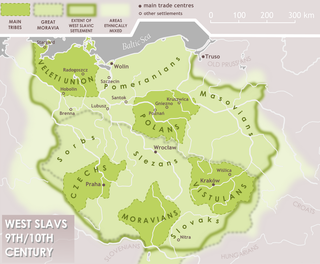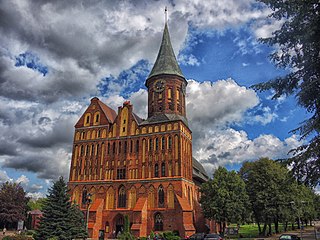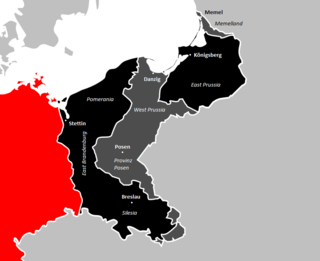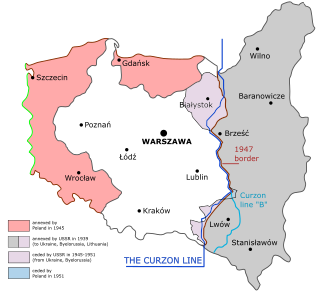
The Pomeranian language is in the Pomeranian group of Lechitic languages within the West Slavic languages.

Pomerania is a historical region on the southern shore of the Baltic Sea in Central Europe, split between Poland and Germany. The central and eastern part belongs to the West Pomeranian, Pomeranian and Kuyavian-Pomeranian voivodeships of Poland, while the western part belongs to the German states of Mecklenburg-Western Pomerania and Brandenburg.

Wends is a historical name for Slavs who inhabited present-day northeast Germany. It refers not to a homogeneous people, but to various people, tribes or groups depending on where and when it was used. In the modern day, communities identifying as Wendish exist in Slovenia, Austria, Lusatia, the United States, and Australia.

Pomerelia, also known as Eastern Pomerania, Vistula Pomerania, and also before World War II as Polish Pomerania, is a historical sub-region of Pomerania on the southern shore of the Baltic Sea in northern Poland.

The Pomeranians, first mentioned as such in the 10th century, were a West Slavic tribe, which from the 5th to the 6th centuries had settled at the shore of the Baltic Sea between the mouths of the Oder and Vistula Rivers. They spoke the Pomeranian language that belonged to the Lechitic languages, a branch of the West Slavic language family.

Prussia is a historical region in Central Europe on the south-eastern coast of the Baltic Sea, that ranges from the Vistula delta in the west to the end of the Curonian Spit in the east and extends inland as far as Masuria, divided between Poland, Russia and Lithuania. This region is often also referred to as Old Prussia.

In present-day Germany, the former eastern territories of Germany refer to those territories east of the current eastern border of Germany, i.e. the Oder–Neisse line, which historically had been considered German and which were annexed by Poland and the Soviet Union after World War II. In contrast to the lands awarded to the restored Polish state by the Treaty of Versailles after World War I, the German territories lost with the post-World War II Potsdam Agreement were either almost exclusively inhabited by Germans before 1945, mixed German–Polish with a German majority, or mixed German–Czech with a German majority (Glatz). Virtually the entire German population of the territories that did not flee voluntarily in the face of the Red Army advance of 1945, was violently expelled to Germany, with their possessions being looted and stolen.

The Duchy of Pomerania was a duchy in Pomerania on the southern coast of the Baltic Sea, ruled by dukes of the House of Pomerania (Griffins). The country existed in the Middle Ages between years 1121–1160, 1264–1295, 1478–1531, and 1625–1637.

The History of Szczecin dates back to the 8th century. Throughout its history the city has been part of Poland, Denmark, Sweden and Germany. Since the Middle Ages, it is one of the largest and oldest cities in the historic region of Pomerania, and today, is it the largest city in northwestern Poland.

The history of Pomerania starts shortly before 1000 AD, with ongoing conquests by newly arrived Polan rulers. Before that, the area was recorded nearly 2000 years ago as Germania, and in modern times Pomerania has been split between Germany and Poland. Its name comes from the Old Polish po more, which means "(land) at the sea".

The Uckermark is a historical region in northeastern Germany, which currently straddles the Uckermark District of Brandenburg and the Vorpommern-Greifswald District of Mecklenburg-Vorpommern. Its traditional capital is Prenzlau.

The Principality of Rügen was a Danish principality, formerly a duchy, consisting of the island of Rügen and the adjacent mainland from 1168 until 1325. It was governed by a local dynasty of princes of the Wizlawiden dynasty. For at least part of this period, Rügen was subject to the Holy Roman Empire.

Pomerania during the Early Middle Ages covers the History of Pomerania from the 7th to the 11th centuries.

Pomerania during the High Middle Ages covers the history of Pomerania in the 12th and 13th centuries.

Pomerania during the Early Modern Age covers the history of Pomerania in the 16th, 17th, and 18th centuries.

The Recovered Territories or Regained Lands, also known as the Western Borderlands, and previously as the Western and Northern Territories, Postulated Territories and Returning Territories, are the former eastern territories of Germany and the Free City of Danzig that became part of Poland after World War II, at which time most of their German inhabitants were forcibly deported.
The Wolinians were a Lechitic tribe in Early Middle Age Pomerania. They were first mentioned as "Velunzani" with 70 civitates by the Bavarian Geographer, ca. 845. Associated with both the Veleti and the Pomeranians, they were based on the island of Wolin and the adjacent mainland. Compared to other tribes of these groups, the Wolinians' territory was relatively small but densely settled: in the 11th century, there was one settlement per four square kilometers. The Wolinians are described by Jan Maria Piskorski as the most powerful Pomeranian tribe. This position resulted from the multi-ethnic emporium at the site of the present-day town of Wolin (Wollin), then known as Jomsborg, Jumne, Julin or Vineta.

Historical Western Pomerania, also called Cispomerania,Fore Pomerania, Front Pomerania or Hither Pomerania, is the western extremity of the historic region of Pomerania forming the southern coast of the Baltic Sea, located mostly in north-eastern Germany, with a small portion in north-western Poland.

Ostsiedlung is the term for the Early Medieval and High Medieval migration of ethnic Germans and Germanization of the areas populated by Slavic, Baltic and Finnic peoples; the most settled area was known as Germania Slavica. Germanization efforts included eastern parts of Francia, East Francia, and the Holy Roman Empire and beyond; and the consequences for settlement development and social structures in the areas of settlement. Other regions were also settled, though not as heavily. The Ostsiedlung encompassed multiple modern and historical regions, primarily Germany east of the Saale and Elbe rivers, the states of Lower Austria and Styria in Austria, Poland and the Czech Republic, but also in other parts of Central and Eastern Europe.
Beginning in the 12th century, on the initiative of monasteries, as well as the local nobility, German settlers began migrating to Pomerania in a process later termed the Ostsiedlung. The local nobles and rulers encouraged the settlement in order to strengthen and consolidate their position and to develop and intensify land use, while the settlers were attracted by the privileges that were granted to them.














